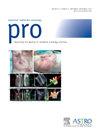前列腺切除术后仅接受 18F - 氟尿嘧啶引导的前列腺床放射治疗患者的无生化复发生存率:前瞻性随机试验的事后分析。
IF 3.4
3区 医学
Q2 ONCOLOGY
引用次数: 0
摘要
目的:在RTOG 0534研究中,与单纯前列腺床(PB)放射治疗相比,全盆腔(WP)放射治疗(放疗)提高了无生化复发生存率(bRFS),但这是在PET分期之前的时代进行的。另外,18F-呋喃妥因 PET/CT (PET)引导的前列腺切除术后放射治疗与仅由传统成像引导的放射治疗相比,可提高 3 年无复发生存率(bRFS)。我们假设,在 PET 之后从 WP 改为纯 PB 放射治疗的患者的 bRFS3 将(a)不高于最初计划接受纯 PB 放射治疗的患者,(b)低于计划接受 WP 放射治疗但未接受 PET 指导的患者:我们对一项前瞻性随机试验进行了事后分析,比较了前列腺切除术后常规放射治疗(第 1 组)与 PET 指导下放射治疗(第 2 组)。在Arm 2中,记录了PET前治疗野的决定,并根据方案定义了PET后治疗野:病理结节阴性(pN0)且无盆腔或盆腔外PET摄取的患者接受纯PB放射治疗。使用 Z 检验和对数秩检验比较了计划接受 WP 放射治疗但最终改为纯 PB 放射治疗的患者[Arm 2 (WP:PB)] 与计划接受纯 PB 放射治疗但最终改为纯 PB 放射治疗的患者[Arm 2(PB:PB)] 和接受 WP 放射治疗的前臂 pN0 患者[Arm 1(WP)]的三年 bRFS。人口统计学数据采用卡方检验(Chi-square test)、费雪精确检验(Fisher's exact test)或方差分析(ANOVA)进行比较:我们确定了 10 名 Arm 2(WP:PB)、31 名 Arm 2(PB:PB)和 11 名 Arm 1(WP)患者。50.0%的Arm 2(WP:PB)和3.2%的Arm 2(PB:PB)患者使用了雄激素剥夺疗法,P结论:与最初计划接受纯PB放射治疗的患者相比,(a)3年bRFS无显著差异;(b)与未接受PET指导的WP放射治疗的患者相比,bRFS有所改善。在 PET 的指导下,对选定的患者减量可能是减轻毒性而不影响疗效的一种方法。本文章由计算机程序翻译,如有差异,请以英文原文为准。
Biochemical Relapse-Free Survival in Postprostatectomy Patients Receiving 18F-Fluciclovine-Guided Prostate Bed-Only Radiation: Post Hoc Analysis of a Prospective Randomized Trial
Purpose
Whole-pelvis (WP) radiation therapy (radiation) improved biochemical relapse-free survival (bRFS) compared with prostate bed (PB)-only radiation in the Radiation Therapy Oncology Group 0534, but was performed in an era prior to positron emission tomography (PET) staging. Separately, 18F-fluciclovine PET/CT-guided postprostatectomy radiation improved 3-year bRFS versus radiation guided by conventional imaging alone. We hypothesized that patients who were changed from WP to PB-only radiation after PET would have bRFS that was: (a) no higher than patients initially planned for PB-only radiation; and (b) lower than patients planned for WP radiation without PET guidance.
Methods and Materials
We conducted a post hoc analysis of a prospective, randomized trial comparing conventional (arm 1) versus PET-guided (arm 2) postprostatectomy radiation. In arm 2, pre-PET treatment field decisions were recorded and post-PET fields were defined per protocol; pathologic node negative (pN0) without pelvic or extrapelvic PET uptake received PB-only radiation. Three-year bRFS was compared in patients planned for WP with change to PB-only radiation (arm 2 [WP:PB]) vs arm 2 patients planned for PB-only with final radiation to PB-only (arm 2 [PB:PB]) and arm 1 pN0 patients treated with WP radiation (arm 1 [WP]) using the Z test and log-rank test. Demographics were compared using the chi-square test, Fisher exact test, or analysis of variance, as appropriate.
Results
We identified 10 arm 2 (WP:PB), 31 arm 2 (PB:PB) and 11 arm 1 (WP) patients. Androgen deprivation was used in 50.0% of arm 2 (WP:PB) and 3.2% of arm 2 (PB:PB) patients, P < .01. Median preradiation prostate-specific antigen was higher in arm 2 (WP:PB) vs arm 2 (PB:PB) patients (0.4 vs 0.2 ng/mL, P = .03); however, there were no significant differences in T stage, Gleason score, or margin positivity. Three-year bRFS was 80% in arm 2 (WP:PB) vs 87.4% in arm 2 (PB:PB), P = .47, respectively. Arm 1(WP) patients had significantly worse 3-year (23%) bRFS vs arm 2 (WP:PB), P < .01.
Conclusions
Patients initially planned for WP radiation with field decision change to PB-only radiation after PET showed (1) no significant difference in 3-year bRFS compared with patients initially planned for PB-only radiation; and (2) improved bRFS compared with patients receiving WP radiation without PET guidance. PET-guided volume de-escalation in selected patients may be 1 approach to mitigating toxicity without compromising outcomes.
求助全文
通过发布文献求助,成功后即可免费获取论文全文。
去求助
来源期刊

Practical Radiation Oncology
Medicine-Radiology, Nuclear Medicine and Imaging
CiteScore
5.20
自引率
6.10%
发文量
177
审稿时长
34 days
期刊介绍:
The overarching mission of Practical Radiation Oncology is to improve the quality of radiation oncology practice. PRO''s purpose is to document the state of current practice, providing background for those in training and continuing education for practitioners, through discussion and illustration of new techniques, evaluation of current practices, and publication of case reports. PRO strives to provide its readers content that emphasizes knowledge "with a purpose." The content of PRO includes:
Original articles focusing on patient safety, quality measurement, or quality improvement initiatives
Original articles focusing on imaging, contouring, target delineation, simulation, treatment planning, immobilization, organ motion, and other practical issues
ASTRO guidelines, position papers, and consensus statements
Essays that highlight enriching personal experiences in caring for cancer patients and their families.
 求助内容:
求助内容: 应助结果提醒方式:
应助结果提醒方式:


